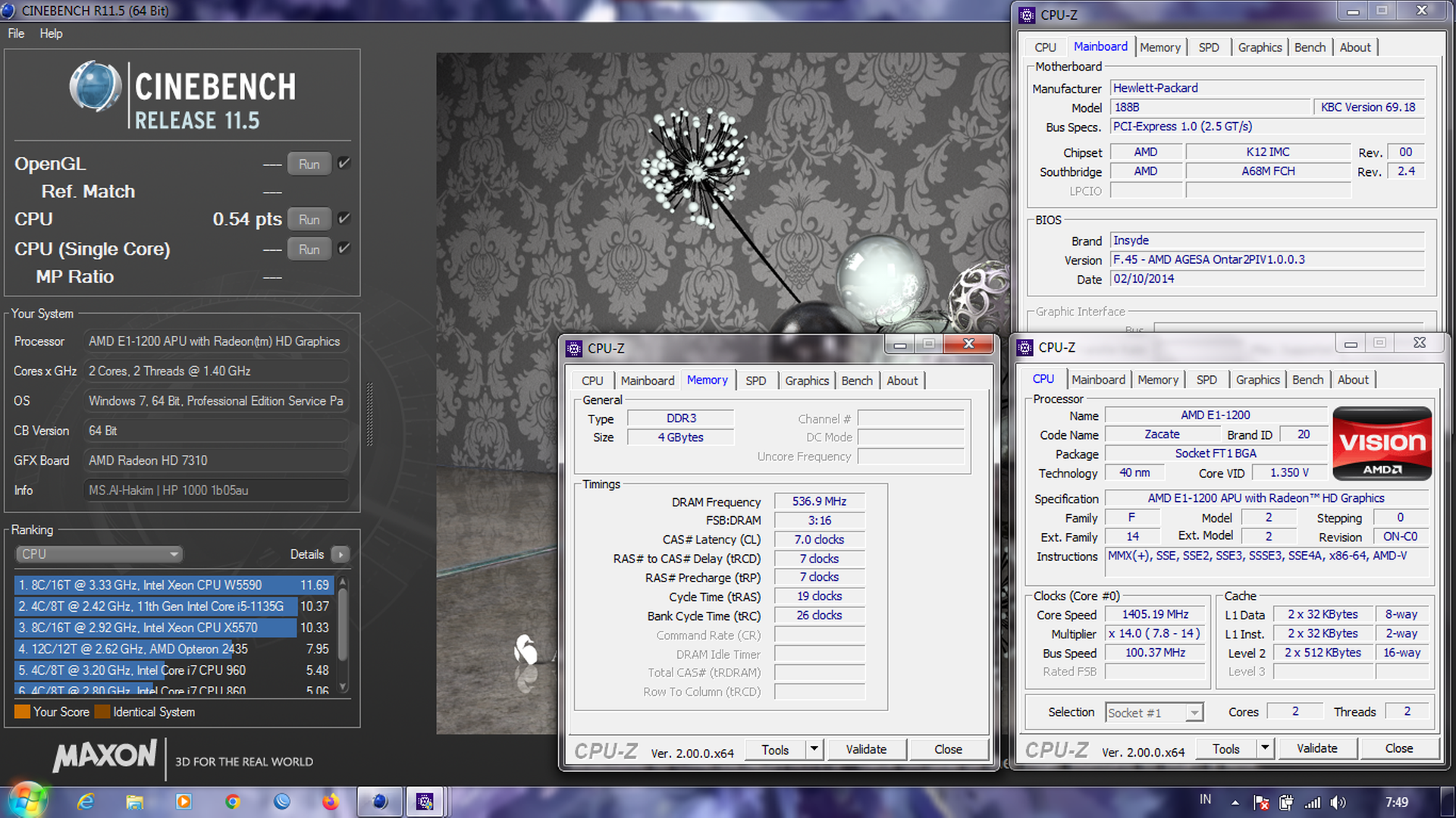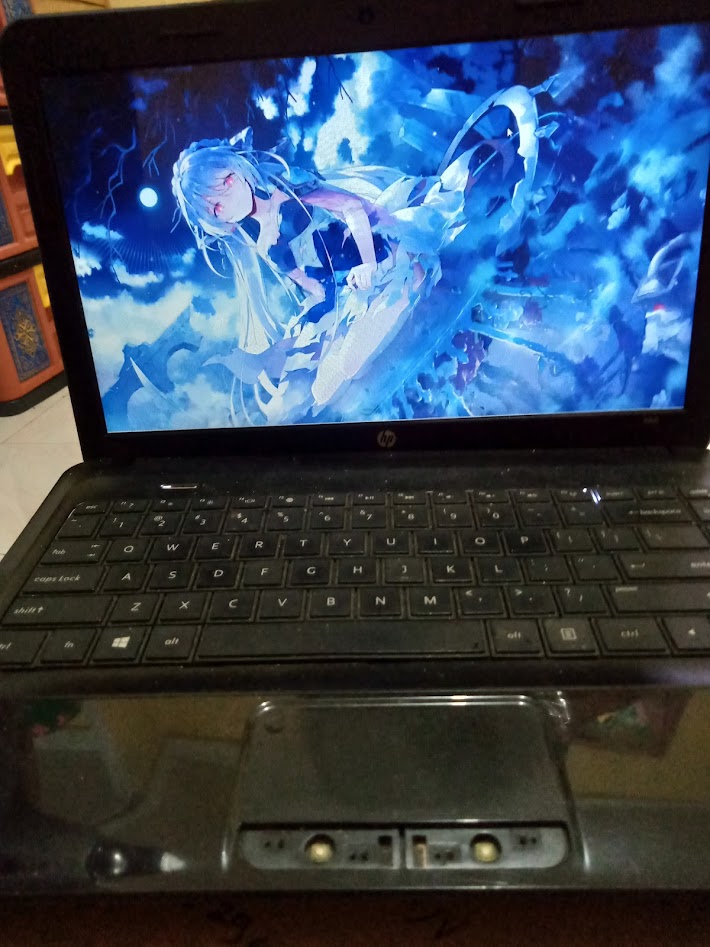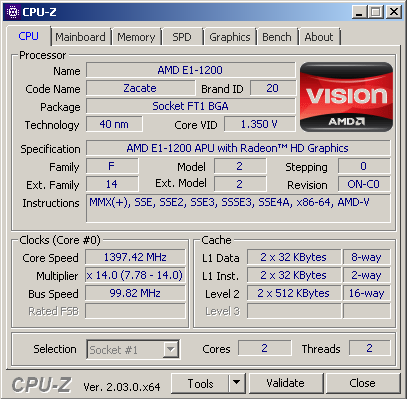Cinebench - R11.5 score 0.54 pts with a E1-1200
Thursday, 01 January 1970 07:00 | Update at null
Media Gallery
Screenshot

Device, Setup, etc



URL
https://hwbot.org/submission/4986470https://www.facebook.com/hakimnu.id/posts/3282137855352188
Information Detail
Hardware: AMD E1-1200
Specs:CPUID : AMD E1-1200 APU with Radeon(TM) HD Graphics
Architecture : x86
Codename : Zacate
L3 Cache : -
Clock : 1.4GHz
Core/Thread : 2/2
TDP : 18W
Technology : 40nm
Socket : FT1 BGA 413-Ball
IGPU : AMD Radeon HD 7310
See more specification...
Software: Cinebench - R11.5
Score: 0.54 pts
About: Cinebench - R11.5Cinebench R11.5 is one of MAXON's popular benchmarks designed to measure CPU performance in complex 3D rendering scenarios. The benchmark is based on the CINEMA 4D rendering engine and is widely used by tech enthusiasts, hardware reviewers, and professionals in the creative industry. Cinebench R11.5 simulates the rendering process of AixSponza's “No Keyframes” animation scene, which consists of thousands of 3D objects and various advanced lighting techniques and visual effects.
One of the key strengths of Cinebench R11.5 is its ability to use up to 64 processor threads in parallel, making it perfect for measuring the overall performance of multi-core CPUs. The test makes use of advanced algorithms such as sharp and blurry reflections, area lighting, realistic shadows, procedural shaders, and anti-aliasing, which represent real workloads in the 3D animation and visualization industry.
The scenes rendered in this benchmark include around 2,000 objects and over 300,000 polygons, making it very demanding for the test system. Test results are given in points (pts), where higher numbers indicate faster and more efficient CPU performance in completing rendering tasks. As such, Cinebench R11.5 is a very useful reference for assessing processor performance in creative and technical applications.
Despite the arrival of newer versions such as R15 and R23, Cinebench R11.5 is still relevant for users who want to make comparisons across processor generations. Many overclockers and users of legacy systems still rely on this version for stability and performance benchmarks due to its realistic yet not too heavy workloads for modern CPUs. With its ability to simulate real-world workflows, Cinebench R11.5 is a great test tool for anyone looking to evaluate their CPU performance in the context of professional rendering.
Released in 2012 as part of the Brazos 2.0 family, the AMD E1-1200 is a power-efficient processor aimed at entry-level laptops. It has a 2 core and 2 thread configuration with a fixed clock speed of 1.4 GHz, with no support for Turbo Core technology. Built with a 40nm fabrication process, the E1-1200 has a TDP value of 18 watts-efficient enough for portable devices that emphasize low power consumption and longer battery life. Despite its limited performance, the E1-1200 was a popular choice in its day thanks to its affordable price and ability to handle light computing needs.
One of the main advantages of the AMD E1-1200 is the integrated Radeon HD 7310 GPU, which offers better graphics performance than Intel's entry-level graphics solutions at the time. This GPU has the ability to play HD resolution videos smoothly, as well as run light games such as Counter Strike 1.6, Plants vs Zombies, or other casual games with minimum graphics settings. That said, this combination of CPU and GPU is not intended for heavy-duty work such as video editing, 3D rendering, or modern gaming. Overall performance is more optimal when used for tasks such as browsing, streaming videos, accessing social media, typing documents, as well as basic office applications.
However, it should be noted that the AMD E1-1200 is less suitable for heavy multitasking, especially in modern operating systems like Windows 10. With a low clock speed and no Boost feature, users may experience lag or limitations when opening multiple applications at once. In tests using the HP 1000 1b05au laptop, this processor was paired with 4GB DDR3 single channel RAM (2 DIMM slots) and tested on Windows 7, Windows 8, and Windows 10 operating systems. The results show that the most optimal performance is achieved on Windows 7 or Windows 8, while in Windows 10 the system tends to be slow although it can still be used for basic needs. As such, the AMD E1-1200 can still be relied upon as a power-efficient and inexpensive solution for users with very light computing needs.
Hardware Detail:
Device: HP 1000 1b05au
RAM: 4GB DDR3 Single Channel 2 DIMM
OS: Windows 7, Windows 8, Windows 10
* Not Avaiable
